PHP中strtotime函数使用方法
php 计算两个时间字符串的差值函数
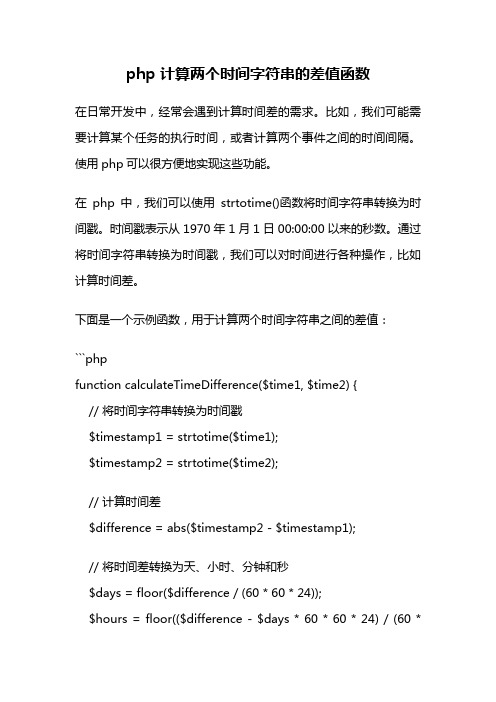
php 计算两个时间字符串的差值函数在日常开发中,经常会遇到计算时间差的需求。
比如,我们可能需要计算某个任务的执行时间,或者计算两个事件之间的时间间隔。
使用php可以很方便地实现这些功能。
在php中,我们可以使用strtotime()函数将时间字符串转换为时间戳。
时间戳表示从1970年1月1日00:00:00以来的秒数。
通过将时间字符串转换为时间戳,我们可以对时间进行各种操作,比如计算时间差。
下面是一个示例函数,用于计算两个时间字符串之间的差值:```phpfunction calculateTimeDifference($time1, $time2) {// 将时间字符串转换为时间戳$timestamp1 = strtotime($time1);$timestamp2 = strtotime($time2);// 计算时间差$difference = abs($timestamp2 - $timestamp1);// 将时间差转换为天、小时、分钟和秒$days = floor($difference / (60 * 60 * 24));$hours = floor(($difference - $days * 60 * 60 * 24) / (60 *60));$minutes = floor(($difference - $days * 60 * 60 * 24 - $hours * 60 * 60) / 60);$seconds = $difference - $days * 60 * 60 * 24 - $hours * 60 * 60 - $minutes * 60;// 返回时间差return "$days 天 $hours 小时 $minutes 分钟 $seconds 秒";}```上述函数接受两个时间字符串作为参数,然后使用strtotime()函数将这两个时间字符串转换为时间戳。
PHP常用字符串函数小结(推荐)

PHP常⽤字符串函数⼩结(推荐)⼀、判断类型的函数is_bool() //判断是否为布尔型is_float() //判断是否为浮点型is_real() //同上is_int() //判断是否为整型is_integer() //同上is_string() //判断是否为字符串is_object() //判断是否为对象is_array() //判断是否为数组is_null() //判断是否为nullis_file() //判断是否为⽂件is_dir() //判断是否为⽬录is_numeric() //判断是否为数字is_nan() //判断不是数字is_resource() //判断是否为资源类型is_a($obj,$classname) //判断对象是否为类的实例//可⽤ if($obj instanceof Classname)⼆、获取⼦串位置strpos($hs,$nd [,int $offset = 0 ]) //返回nd 在 hs 中⾸次出现的数字位置。
stripos($hs,$nd [,int $offset = 0 ]) //返回nd 在 hs 中⾸次出现的数字位置, 不区分⼤⼩写。
strrpos($hs,$nd [,int $offset = 0 ]) //返回nd 在 hs 中最后⼀次出现的数字位置。
strripos($hs,$nd [,int $offset = 0 ]) //返回nd 在 hs 中最后⼀次出现的数字位置,不区分⼤⼩写。
三、获取⼦串substr($str,$start [,$length]); //获取⼦串substr_compare($main_str,$str,$offset[,$length]); //⼦串⽐较从offset处开始⽐较substr_count($hs,$nd [,$offset=0 [,$length]]); //获取⼦串nd在hs中出现的次数substr_replace($string,$replacement,$start [,$length]); //字符串⼦串替换//⽤$replacement替换掉$string从start开始长度为length的⼦串strstr($hys,$nd [,bool $before_needle = false ]);//返回$nd在$hys 第⼀次出现的地⽅开始到字符串结束为⽌的字符串//第三个参数如果为true 则返回$nd 之前的字符串stristr($hys,$nd [,bool $before_needle = false ]); //同上,忽略⼤⼩写版本strrchr($hys,$nd); //返回$nd在$hys最后⼀次出现的地⽅开始到字符串结束为⽌的字符串//⼀般和 substr(strrchr($hys,$nd),strlen($nd)); 合⽤strpbrk($haystack,$char_list);//从$char_list中依次匹配单个字符在$haystack中第⼀次出现的地⽅//到字符串结束的地⽅的整个字符串strtok($str,$token); //第⼀次使⽤将字符串按分隔符$token进⾏分割strtok($token); //第⼆次使⽤eg.$string = "This is\tan example\nstring";/* 使⽤制表符和换⾏符作为分界符 */$tok = strtok($string, " \n\t");while ($tok !== false) {echo "Word=$tok<br />";$tok = strtok(" \n\t");}四、字符串str_ 型函数str_getcsv($str); //将csv⽂件字符串转换成⼀个数组str_replace($search,$replace,$subject [,&$count]);//搜索并替换字符串//第四个参数被指定的话,将会赋值给他替换的次数str_ireplace($search,$replace,$subject [,&$count]);//搜索并替换字符串//第四个参数被指定的话,将会赋值给他替换的次数忽略⼤⼩写str_shuffle(string $str);//随机打乱字符串str_split($str [,$len=1]);//将字符串转换成⼀个数组//,每个数组单元的长度为$len五、字符串长度strlen($str); //字符串长度六、翻转字符串strrev(string $string);// 翻转字符串七、mb_类型字符串函数mb_类型字符串与上述字符串函数基本⼀样,只是加多⼀个可选的字符编码参数,⽤法同上这⾥列出⼀些其他有⽤函数1、检测字符串的字符编码$encode = mb_detect_encoding($lines, array("ASCII","UTF-8","GB2312","GBK","BIG5"));if($encode != "UTF-8"){$lines = iconv($encode,"UTF-8", $lines);}⼋、字符串的相关操作1、转换字符串类型strval($str); //转换成字符串类型floatval($str);//转换成浮点型intval($str); //转换成整型2、⼤⼩写转换strtolower($str); //全部转换成⼩写strtoupper($str); //全部转换成⼤写3、字符串转时间戳strtotime($str); //时间格式的字符串转换成整型时间戳//注意设置时区否则会有 8⼩时误差4、去除HTML 和 PHP 标记strip_tags($str [,$tags]);//去除不含$tags⾥标签外的所有标签5、ascii转数字数字转asciichr(int $ascii); //数字转换成asciiord(string $str); //返回$str第⼀个字符的ascii值6、json的编码与解码json_encode($obj/$arr/$str...);//编码成json 格式的字符串json_decode($jsonstr [,$assoc=true]); //解码成对象//当$assoc=true 时返回数组⽽⾮对象7、换⾏转<br/>nl2br($str); //字符串 $str 所有新⾏之前插⼊'<br/>'8、数组转字符串,字符串转数组implode($arr,$glue);//将⼀维数组转换为字符串explode();//字符串转换为数组9、千位分割格式化string number_format ( float $number [, int $decimals = 0 ] )string number_format ( float $number , int $decimals = 0 , string $dec_point = '.' , string $thousands_sep = ',' ) @param $number 你要格式化的数字$decimals 要保留的⼩数位数$dec_point 指定⼩数点显⽰的字符$thousands_sep 指定千位分隔符显⽰的字符10、去空格trim(string $str [,string $charlist ]); //去左右字符ltrim(string $str [,string $charlist ]); //去左字符rtrim(string $str [,string $charlist ]); //去右字符该函数删除 str 末端的空⽩字符并返回。
php实现倒计时效果
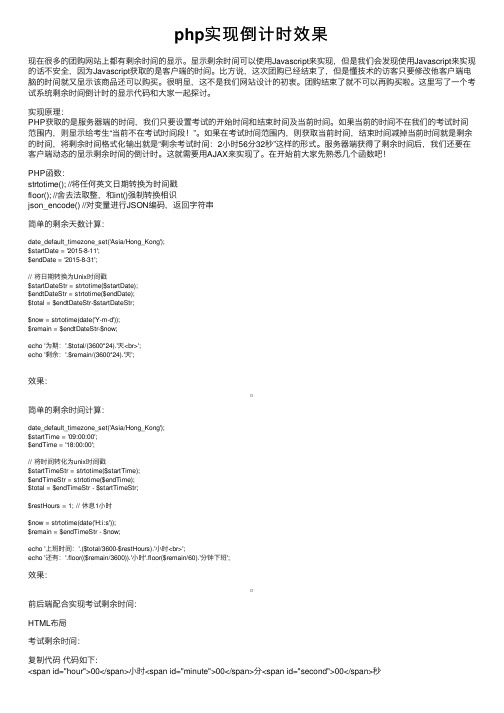
php实现倒计时效果现在很多的团购⽹站上都有剩余时间的显⽰。
显⽰剩余时间可以使⽤Javascript来实现,但是我们会发现使⽤Javascript来实现的话不安全,因为Javascript获取的是客户端的时间。
⽐⽅说,这次团购已经结束了,但是懂技术的访客只要修改他客户端电脑的时间就⼜显⽰该商品还可以购买。
很明显,这不是我们⽹站设计的初衷。
团购结束了就不可以再购买啦。
这⾥写了⼀个考试系统剩余时间倒计时的显⽰代码和⼤家⼀起探讨。
实现原理:PHP获取的是服务器端的时间,我们只要设置考试的开始时间和结束时间及当前时间。
如果当前的时间不在我们的考试时间范围内,则显⽰给考⽣“当前不在考试时间段!”。
如果在考试时间范围内,则获取当前时间,结束时间减掉当前时间就是剩余的时间,将剩余时间格式化输出就是“剩余考试时间:2⼩时56分32秒”这样的形式。
服务器端获得了剩余时间后,我们还要在客户端动态的显⽰剩余时间的倒计时。
这就需要⽤AJAX来实现了。
在开始前⼤家先熟悉⼏个函数吧!PHP函数:strtotime(); //将任何英⽂⽇期转换为时间戳floor(); //舍去法取整,和int()强制转换相识json_encode() //对变量进⾏JSON编码,返回字符串简单的剩余天数计算:date_default_timezone_set('Asia/Hong_Kong');$startDate = '2015-8-11';$endDate = '2015-8-31';// 将⽇期转换为Unix时间戳$startDateStr = strtotime($startDate);$endtDateStr = strtotime($endDate);$total = $endtDateStr-$startDateStr;$now = strtotime(date('Y-m-d'));$remain = $endtDateStr-$now;echo '为期:'.$total/(3600*24).'天<br>';echo '剩余:'.$remain/(3600*24).'天';效果:简单的剩余时间计算:date_default_timezone_set('Asia/Hong_Kong');$startTime = '09:00:00';$endTime = '18:00:00';// 将时间转化为unix时间戳$startTimeStr = strtotime($startTime);$endTimeStr = strtotime($endTime);$total = $endTimeStr - $startTimeStr;$restHours = 1; // 休息1⼩时$now = strtotime(date('H:i:s'));$remain = $endTimeStr - $now;echo '上班时间:'.($total/3600-$restHours).'⼩时<br>';echo '还有:'.floor(($remain/3600)).'⼩时'.floor($remain/60).'分钟下班';效果:前后端配合实现考试剩余时间:HTML布局考试剩余时间:复制代码代码如下:<span id="hour">00</span>⼩时<span id="minute">00</span>分<span id="second">00</span>秒JS脚本function dealData(id,value){var place = document.getElementById(id);place.innerHTML = value;}window.setInterval(function(){ // 每秒从服务器取⼀次数据var ajax = new Ajax();ajax.get("remain_time.php?a="+Math.random(),function(data){eval("var dtime = "+data);dealData('hour',dtime.hour);dealData('minute',dtime.minute);dealData('second',dtime.second);});},1000);PHP代码:date_default_timezone_set('PRC');$start_time = '09:00:00';$end_time = '18:00:00';$start_famate_time = strtotime($start_time);//开始时间转化为时间戳$end_famate_time = strtotime($end_time); //结束时间转化为时间戳$now_time = time();if($end_famate_time < $now_time || $start_time > $now_time){echo '当前不在考试的时间范围内!';exit;}$remain_time = $end_famate_time-$now_time; //剩余的秒数$remain_hour = floor($remain_time/(60*60)); //剩余的⼩时$remain_minute = floor(($remain_time - $remain_hour*60*60)/60); //剩余的分钟数$remain_second = ($remain_time - $remain_hour*60*60 - $remain_minute*60); //剩余的秒数echo json_encode(array('hour'=>$remain_hour,'minute'=>$remain_minute,'second'=>$remain_second));以上就是php实现倒计时的关键代码,希望对⼤家的学习有所帮助。
php wheretime用法

php wheretime用法PHP中的whereTime用法在PHP中,whereTime是一个非常有用的函数,它可以帮助我们在数据库中查询指定时间段内的数据。
在本文中,我们将深入探讨whereTime的用法,以及如何在PHP中使用它来查询数据。
什么是whereTime?whereTime是一个用于查询指定时间段内数据的函数。
它可以帮助我们在数据库中查询指定时间段内的数据,例如查询最近一周、一个月或一年内的数据。
whereTime函数可以用于各种类型的数据库,包括MySQL、PostgreSQL和SQLite等。
whereTime的语法whereTime函数的语法如下:```whereTime($field, $op, $time)```其中,$field是要查询的字段名,$op是比较运算符,$time是要比较的时间。
$op可以是以下运算符之一:- eq:等于- neq:不等于- gt:大于- egt:大于等于- lt:小于- elt:小于等于$time可以是一个时间戳,也可以是一个日期字符串。
如果是一个日期字符串,它必须符合PHP的日期格式。
whereTime的用法下面是一个使用whereTime函数查询最近一周数据的示例:```$week_ago = strtotime('-1 week');$data = Db::table('table_name')->whereTime('create_time', '>', $week_ago)->select();```在这个示例中,我们使用strtotime函数获取了一周前的时间戳,然后使用whereTime函数查询create_time字段大于这个时间戳的数据。
最后,我们使用select函数获取查询结果。
下面是一个使用whereTime函数查询最近一个月数据的示例:```$month_ago = strtotime('-1 month');$data = Db::table('table_name')->whereTime('create_time', '>', $month_ago)->select();```在这个示例中,我们使用strtotime函数获取了一个月前的时间戳,然后使用whereTime函数查询create_time字段大于这个时间戳的数据。
PHP日期时间函数大全
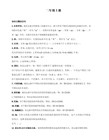
//本周
$thisweek_start = date("Y-m-d H:i:s",mktime(0, 0 , 0,date("m"),date("d")-date("w")+1,date("Y")));
?>
mktime($hour, $minute, $second, $month, $day, $year)
此函数的作用与getdate()的作用相反:它由一系列的日期与时间值生成一个UNIX时间标签(GMT时间1970年1月1日到现在消逝的秒数)。不用自变量时,它生成当前时间的UNIX时间标签。
今天是:Tuesday
echo date('D');
今天是:Tue
大写L表示判断今年是否闰年,布尔值,为真返回1,否则为0;
小写l表示当天是星期几的英文全写(Tuesday);
而使用大写D表示星期几的3个字符缩写(Tue)。
echo date('w');
今天星期:2
echo date('W');
// run some code
for ($x=0; $x<1000; $x++) {
$null = $x * $x;
}
// get ending value
strtotime参数

strtotime参数strtotime参数是一个在编程中常用的函数,用于将字符串转换为时间戳。
时间戳是指自1970年1月1日0时0分0秒(UTC)以来的秒数。
在本文中,我们将探讨strtotime参数的用法和一些常见的应用场景。
一、strtotime参数的用法strtotime参数可以接受多种不同格式的字符串,并将其转换为时间戳。
以下是一些常见的用法示例:1. 将日期字符串转换为时间戳:$timestamp = strtotime("2022-01-01"); // 将2022年1月1日转换为时间戳2. 将带有时间的字符串转换为时间戳:$timestamp = strtotime("2022-01-01 12:00:00"); // 将2022年1月1日12时转换为时间戳3. 将相对时间字符串转换为时间戳:$timestamp = strtotime("+1 day"); // 将当前时间加一天后的时间转换为时间戳4. 将特定格式的字符串转换为时间戳:$timestamp = strtotime("12pm January 1 2022"); // 将2022年1月1日下午12时转换为时间戳strtotime参数在编程中有着广泛的应用,特别是在处理时间相关的操作中。
下面是一些常见的应用场景:1. 日期比较:通过将日期字符串转换为时间戳,可以方便地进行日期的比较。
例如,我们可以比较两个日期的大小,判断哪一个日期在前面或后面。
2. 时间计算:通过将相对时间字符串转换为时间戳,可以对时间进行加减运算。
例如,我们可以计算某个日期之后或之前的日期。
3. 时间格式化:通过将时间戳转换为指定格式的字符串,可以实现时间的格式化输出。
例如,我们可以将时间戳转换为"年-月-日时:分:秒"的格式。
4. 判断日期是否合法:通过将日期字符串转换为时间戳,可以判断一个日期是否合法。
php中strtotime参数
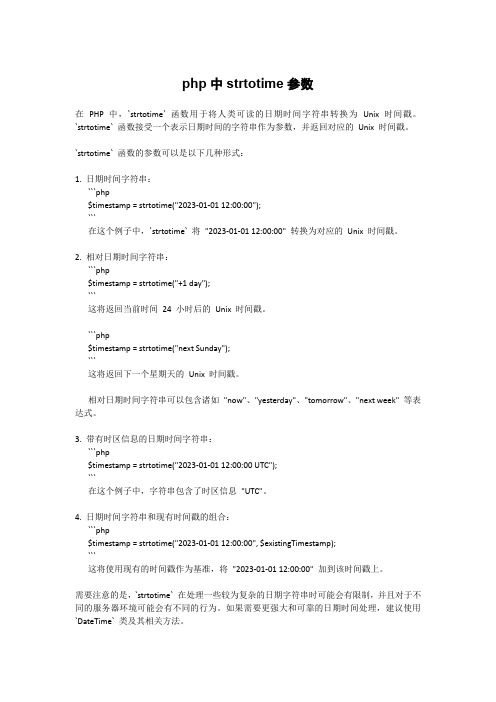
php中strtotime参数在PHP 中,`strtotime` 函数用于将人类可读的日期时间字符串转换为Unix 时间戳。
`strtotime` 函数接受一个表示日期时间的字符串作为参数,并返回对应的Unix 时间戳。
`strtotime` 函数的参数可以是以下几种形式:1. 日期时间字符串:```php$timestamp = strtotime("2023-01-01 12:00:00");```在这个例子中,`strtotime` 将"2023-01-01 12:00:00" 转换为对应的Unix 时间戳。
2. 相对日期时间字符串:```php$timestamp = strtotime("+1 day");```这将返回当前时间24 小时后的Unix 时间戳。
```php$timestamp = strtotime("next Sunday");```这将返回下一个星期天的Unix 时间戳。
相对日期时间字符串可以包含诸如"now"、"yesterday"、"tomorrow"、"next week" 等表达式。
3. 带有时区信息的日期时间字符串:```php$timestamp = strtotime("2023-01-01 12:00:00 UTC");```在这个例子中,字符串包含了时区信息"UTC"。
4. 日期时间字符串和现有时间戳的组合:```php$timestamp = strtotime("2023-01-01 12:00:00", $existingTimestamp);```这将使用现有的时间戳作为基准,将"2023-01-01 12:00:00" 加到该时间戳上。
php 时间差计算函数
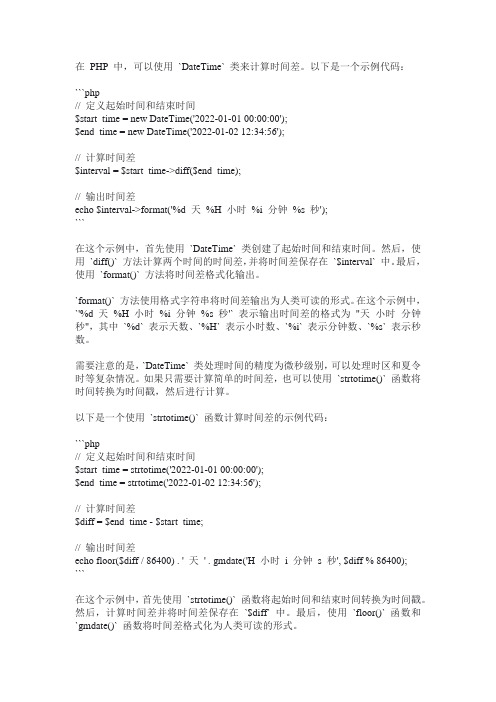
在PHP 中,可以使用`DateTime` 类来计算时间差。
以下是一个示例代码:```php// 定义起始时间和结束时间$start_time = new DateTime('2022-01-01 00:00:00');$end_time = new DateTime('2022-01-02 12:34:56');// 计算时间差$interval = $start_time->diff($end_time);// 输出时间差echo $interval->format('%d 天%H 小时%i 分钟%s 秒');```在这个示例中,首先使用`DateTime` 类创建了起始时间和结束时间。
然后,使用`diff()` 方法计算两个时间的时间差,并将时间差保存在`$interval` 中。
最后,使用`format()` 方法将时间差格式化输出。
`format()` 方法使用格式字符串将时间差输出为人类可读的形式。
在这个示例中,`'%d 天%H 小时%i 分钟%s 秒'` 表示输出时间差的格式为"天小时分钟秒",其中`%d` 表示天数、`%H` 表示小时数、`%i` 表示分钟数、`%s` 表示秒数。
需要注意的是,`DateTime` 类处理时间的精度为微秒级别,可以处理时区和夏令时等复杂情况。
如果只需要计算简单的时间差,也可以使用`strtotime()` 函数将时间转换为时间戳,然后进行计算。
以下是一个使用`strtotime()` 函数计算时间差的示例代码:```php// 定义起始时间和结束时间$start_time = strtotime('2022-01-01 00:00:00');$end_time = strtotime('2022-01-02 12:34:56');// 计算时间差$diff = $end_time - $start_time;// 输出时间差echo floor($diff / 86400) . ' 天' . gmdate('H 小时i 分钟s 秒', $diff % 86400);```在这个示例中,首先使用`strtotime()` 函数将起始时间和结束时间转换为时间戳。
php如何实现万年历的开发(每日一课真是非常有效率)
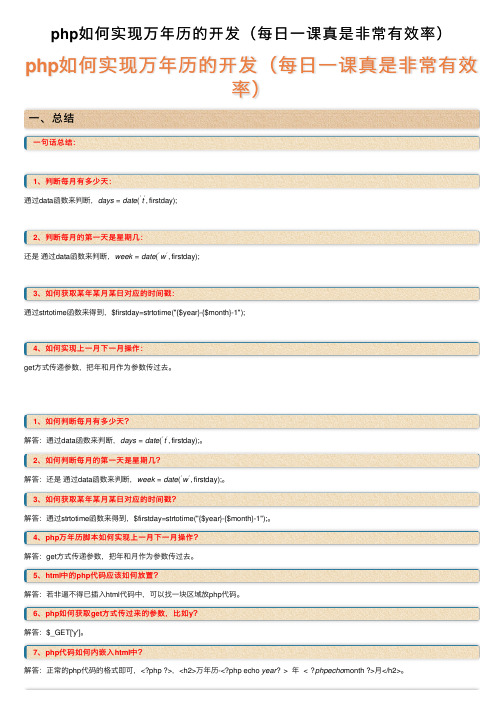
php如何实现万年历的开发(每⽇⼀课真是⾮常有效率)php如何实现万年历的开发(每⽇⼀课真是⾮常有效率)⼀、总结⼀句话总结:1、判断每⽉有多少天:通过data函数来判断,days=date(′t′,firstday);2、判断每⽉的第⼀天是星期⼏:还是通过data函数来判断,week=date(′w′,firstday);3、如何获取某年某⽉某⽇对应的时间戳:通过strtotime函数来得到,$firstday=strtotime("{$year}-{$month}-1");4、如何实现上⼀⽉下⼀⽉操作:get⽅式传递参数,把年和⽉作为参数传过去。
1、如何判断每⽉有多少天?解答:通过data函数来判断,days=date(′t′,firstday);。
2、如何判断每⽉的第⼀天是星期⼏?解答:还是通过data函数来判断,week=date(′w′,firstday);。
3、如何获取某年某⽉某⽇对应的时间戳?解答:通过strtotime函数来得到,$firstday=strtotime("{$year}-{$month}-1");。
4、php万年历脚本如何实现上⼀⽉下⼀⽉操作?解答:get⽅式传递参数,把年和⽉作为参数传过去。
5、html中的php代码应该如何放置?解答:若⾮逼不得已插⼊html代码中,可以找⼀块区域放php代码。
6、php如何获取get⽅式传过来的参数,⽐如y?解答:$_GET['y']。
7、php代码如何内嵌⼊html中?解答:正常的php代码的格式即可,<?php ?>,<h2>万年历-<?php echo year?>年<?phpecho month ?>⽉</h2>。
8、php万年历如何在每⽉1号的前⾯把该空出来的格⼦空出来?解答:把他们依次看成0,-1,-2,-3等等,然后i从(1-week)开始取i=(1-$week);,然后那些⼩于1对应的格⼦td⾥⾯就输出空格就好。
PHP时间日期增减操作示例【datestrtotime实现加一天、加一月等操作】
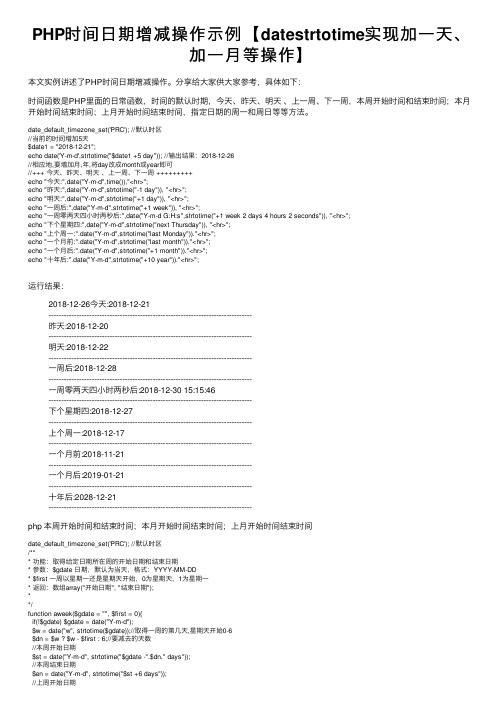
PHP时间⽇期增减操作⽰例【datestrtotime实现加⼀天、加⼀⽉等操作】本⽂实例讲述了PHP时间⽇期增减操作。
分享给⼤家供⼤家参考,具体如下:时间函数是PHP⾥⾯的⽇常函数,时间的默认时期,今天、昨天、明天、上⼀周、下⼀周,本周开始时间和结束时间;本⽉开始时间结束时间;上⽉开始时间结束时间,指定⽇期的周⼀和周⽇等等⽅法。
date_default_timezone_set('PRC'); //默认时区//当前的时间增加5天$date1 = "2018-12-21";echo date('Y-m-d',strtotime("$date1 +5 day")); //输出结果:2018-12-26//相应地,要增加⽉,年,将day改成month或year即可//+++ 今天、昨天、明天、上⼀周、下⼀周 +++++++++echo "今天:",date("Y-m-d",time()),"<hr>";echo "昨天:",date("Y-m-d",strtotime("-1 day")), "<hr>";echo "明天:",date("Y-m-d",strtotime("+1 day")), "<hr>";echo "⼀周后:",date("Y-m-d",strtotime("+1 week")), "<hr>";echo "⼀周零两天四⼩时两秒后:",date("Y-m-d G:H:s",strtotime("+1 week 2 days 4 hours 2 seconds")), "<hr>";echo "下个星期四:",date("Y-m-d",strtotime("next Thursday")), "<hr>";echo "上个周⼀:".date("Y-m-d",strtotime("last Monday"))."<hr>";echo "⼀个⽉前:".date("Y-m-d",strtotime("last month"))."<hr>";echo "⼀个⽉后:".date("Y-m-d",strtotime("+1 month"))."<hr>";echo "⼗年后:".date("Y-m-d",strtotime("+10 year"))."<hr>";运⾏结果:2018-12-26今天:2018-12-21--------------------------------------------------------------------------------昨天:2018-12-20--------------------------------------------------------------------------------明天:2018-12-22--------------------------------------------------------------------------------⼀周后:2018-12-28--------------------------------------------------------------------------------⼀周零两天四⼩时两秒后:2018-12-30 15:15:46--------------------------------------------------------------------------------下个星期四:2018-12-27--------------------------------------------------------------------------------上个周⼀:2018-12-17--------------------------------------------------------------------------------⼀个⽉前:2018-11-21--------------------------------------------------------------------------------⼀个⽉后:2019-01-21--------------------------------------------------------------------------------⼗年后:2028-12-21--------------------------------------------------------------------------------php 本周开始时间和结束时间;本⽉开始时间结束时间;上⽉开始时间结束时间date_default_timezone_set('PRC'); //默认时区/*** 功能:取得给定⽇期所在周的开始⽇期和结束⽇期* 参数:$gdate ⽇期,默认为当天,格式:YYYY-MM-DD* $first ⼀周以星期⼀还是星期天开始,0为星期天,1为星期⼀* 返回:数组array("开始⽇期", "结束⽇期");**/function aweek($gdate = "", $first = 0){if(!$gdate) $gdate = date("Y-m-d");$w = date("w", strtotime($gdate));//取得⼀周的第⼏天,星期天开始0-6$dn = $w ? $w - $first : 6;//要减去的天数//本周开始⽇期$st = date("Y-m-d", strtotime("$gdate -".$dn." days"));//本周结束⽇期$en = date("Y-m-d", strtotime("$st +6 days"));//上周开始⽇期$last_st = date('Y-m-d',strtotime("$st - 7 days"));//上周结束⽇期$last_en = date('Y-m-d',strtotime("$st - 1 days"));return array($st, $en,$last_st,$last_en);//返回开始和结束⽇期}echo implode("|", aweek("", 1)).'<br />';//echo date("Y-m-d",strtotime("time()"));echo '本周第⼀天(星期⽇为⼀周开始):'.date('Y-m-d', time()-86400*date('w')).'<hr>';echo '本周第⼀天(星期⼀为⼀周开始):'.date('Y-m-d', time()-86400*date('w')+(date('w')>0?86400:-6*86400)).'<hr>'; echo '本⽉第⼀天:'.date('Y-m-d', mktime(0,0,0,date('m'),1,date('Y'))).'<hr>';echo '本⽉最后⼀天:'.date('Y-m-d', mktime(0,0,0,date('m'),date('t'),date('Y'))).'<hr>';//上个⽉的开始⽇期$m = date('Y-m-d', mktime(0,0,0,date('m')-1,1,date('Y')));//上个⽉共多少天$t = date('t',strtotime("$m"));echo '上⽉第⼀天:'.date('Y-m-d', mktime(0,0,0,date('m')-1,1,date('Y'))).'<hr>';echo '上⽉最后⼀天:'.date('Y-m-d', mktime(0,0,0,date('m')-1,$t,date('Y'))).'<hr>';运⾏结果:2018-12-17|2018-12-23|2018-12-10|2018-12-16本周第⼀天(星期⽇为⼀周开始):2018-12-16--------------------------------------------------------------------------------本周第⼀天(星期⼀为⼀周开始):2018-12-17--------------------------------------------------------------------------------本⽉第⼀天:2018-12-01--------------------------------------------------------------------------------本⽉最后⼀天:2018-12-31--------------------------------------------------------------------------------上⽉第⼀天:2018-11-01--------------------------------------------------------------------------------上⽉最后⼀天:2018-11-30--------------------------------------------------------------------------------//PHP⼿册上有⼀个这个⽅法,⽤来返回指定⽇期的周⼀和周⽇function get_week_range($week, $year){$timestamp = mktime(1,0,0,1,1,$year);$firstday = date("N",$timestamp);if($firstday >4){$firstweek = strtotime('+'.(8-$firstday).' days', $timestamp);}else{$firstweek = strtotime('-'.($firstday-1).' days', $timestamp);}$monday = strtotime('+'.($week - 1).' week', $firstweek);$sunday = strtotime('+6 days', $monday);$start = date("Y-m-d", $monday);$end = date("Y-m-d", $sunday);return array($start, $end);}//strtotime获取本周第⼀天和最后⼀天⽅法的BUG//PHP⼿册上有⼀个这个⽅法,⽤来返回指定⽇期的周⼀和周⽇function get_week_range2($week, $year){$timestamp = mktime(1,0,0,1,1,$year);$firstday = date("N",$timestamp);if($firstday >4){$firstweek = strtotime('+'.(8-$firstday).' days', $timestamp);}else{$firstweek = strtotime('-'.($firstday-1).' days', $timestamp);}$monday = strtotime('+'.($week - 1).' week', $firstweek);$sunday = strtotime('+6 days', $monday);$start = date("Y-m-d", $monday);$end = date("Y-m-d", $sunday);return array($start, $end);}但在跨年的时候使⽤会有问题例如2011年的12⽉31⽇周六和2012年1⽉1⽇周⽇,拿到的周⼀和周⽇完全不同2011年12⽉31⽇拿合到的周⼀和周⽇分别对应2011-12-262012-01-01但2012年1⽉1⽇拿到的周⼀和周⽇分别对应2012-01-022012-01-04原因为传进去的⽅法的周为第53周,但是年为2011年,所以认为2011的第53周,所以计算有误,解决⽅法为,如果周为⼤于10(因为⼀⽉个⽉不可能有10周),且⽉份为1的时候,将年减1处理if(date('m',$last_week_time) == '01' and $tmp_last_week > 10){$last_week_year--;}PS:这⾥再为⼤家推荐⼏款时间及⽇期相关⼯具供⼤家参考:更多关于PHP相关内容感兴趣的读者可查看本站专题:《》、《》、《》、《》、《》、《》、《》及《》希望本⽂所述对⼤家PHP程序设计有所帮助。
php基础函数数组函数字符串函数
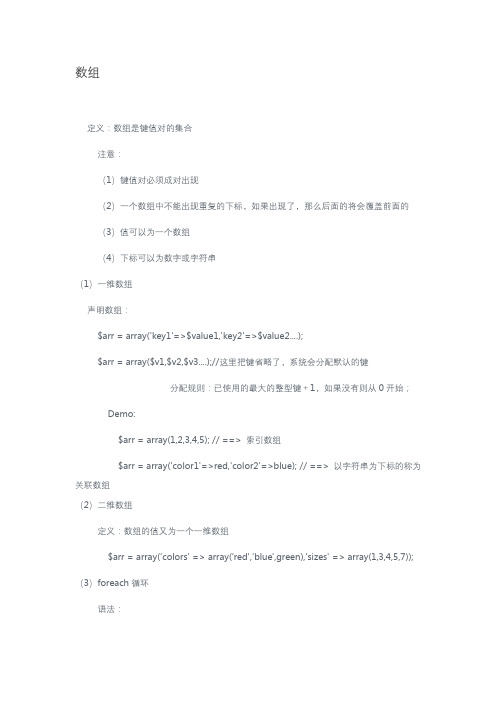
数组定义:数组是键值对的集合注意:(1)键值对必须成对出现(2)一个数组中不能出现重复的下标,如果出现了,那么后面的将会覆盖前面的(3)值可以为一个数组(4)下标可以为数字或字符串(1)一维数组声明数组:$arr = array('key1'=>$value1,'key2'=>$value2....);$arr = array($v1,$v2,$v3....);//这里把键省略了,系统会分配默认的键分配规则:已使用的最大的整型键+1,如果没有则从0开始;Demo:$arr = array(1,2,3,4,5); // ==>索引数组$arr = array('color1'=>red,'color2'=>blue); // ==>以字符串为下标的称为关联数组(2)二维数组定义:数组的值又为一个一维数组$arr = array('colors' => array('red','blue',green),'sizes' => array(1,3,4,5,7));(3)foreach循环语法:foreach($arr as $key => $val){}(1)数学函数绝对值:abs($number) 返回非负数四舍五入:round($floatnum[,$num]) 返回浮点数,后面的参数为可选,表示保留几位小数,当为负数时表示往小数点前取位,默认取整向上取整:ceil() 返回浮点数,如ceil(3.13) 结果为4向下取整:floor($number) 返回浮点数,如floor(3.93) 结果为3取平方根:sqrt($float) 返回浮点数幂:pow($number,$exp) 返回数值型,两个参数都为数值型最大值:max($num1,$num2...$numX) 返回最大的那个数最小值:min($num1,$num2...$numX) 返回最小的那个数取随机数:rand([$min,$max]) 参数为可选mt_rand([$min,$max]) 精度要高于rand(),即重复的机率要远低于rand() (2)时间函数time(); 返回当前时间戳date('Y-m-d H:i:s'[,time()]); 当前时间日期格式时间格式:y 两位数年份,Y 四位数年份m 两位数月份,n 一位数月份,M 英文月份的前三位,F 英文月份全写d 两位数日期,j 一位数日期w 星期中的第几天0-6,D 星期的英文前三个字母,N 星期中的第几天1-7 ,W 一年中的第几周h 小时00-11,*H 小时00-23,g 小时1-12,G 小时0-23i 分钟00-59s 秒00-59a am或pm,A AM或PMmicrotime() 获取当前时间,微秒级,样式:0.98903200 1337159287,多用于测试程序运行时间,或取随机数date_default_timezone_set("PRC") 设置时间的函数date_default_timezone_get() 获取当前设置的时区strtotime('$timestring') 把时间格式的字符串转换成时间戳Demo:echo strtotime('2012-01-01'); //不写时间则默认为00:00:00也可以直接使用days、weeks、months、years对时间描述直接使用Demo:echo strtotime("-1 days");//输出前一天的时间echo strtotime("+1 week 2 days 4 hours 2 seconds");今日作业:8485868788899091字符串函数注:字符串有一个索引下标,如$str = “abcd”a-d从左至右的下标依次为0,1,2,3;可以用$str[0]或$str{0}输出aint strlen($string)获取字符串长度,返回int型mix strpos($string,$find[,$start])获取某字符串在另一个字符串中第一次出现的位置,返回下标值,如果不存在则返回false$start可选,为开始查找的位置//pos为position的简写判断某字符串是否包含在另一字符串中时需用全等===flase来判断,因为第一个下标值是0 mix strrpos($string,$find[,$start])返回某字符串在另一字符串中最后一次出现的位置注:另有stripos、strripos与上面两个一样,只是不区分大小写int iconv_strrpos($string,$find[,$encode])统计$find在$string中最后出现的位置,指定编码后可用于查找中文mix strstr($string,$findstr)查找某字符串是否在另一字符串中,如果不存在则返回false,区分大小写,别名strchr如果存在,返回查找到的字符串开始至被查找的字符串结束Demo:$str = 'abcfdfgdgs';var_dump(strstr($str,'dfg'));mix stristr($string,$findstr)与strstr相同,但是不区分大小写mix strrchr($string,$findstr)与strstr相同,但是返回的是查找到的最后一个结果Demo:$str = 'abcfdabcgs';var_dump(strstr($str,'abc'));//output abcgsstr substr($string,$start[,$length])截取字符串的一部分,$length不写时,截取从开始位置至字符串结束$start为负数时,为从后往前数第n位$length为负数时,$length为截取结束的位置Demo:$str = 'abcfdfgdgs';echo substr($str,-4,-2);//output gdbool iconv(in_code,out_code,$string)把$string从in_code编码转成out_code编码int mb_strlen($string[,$encode])使用$encode时返回字符串的字符数,同iconv_strlen一样str mb_substr($string,$start[,$length[,$encode]])类似substr,截取字符串,同iconv_substr一样使用第四个param声明字符集时,$start与$length都以字符数计算而不以字节数计算,这样就可以实现汉字截取不会乱码str mb_strcut($string,$start[,$length[,$encode]])与mb_substr一样,但是是以字节数计算的注:mb_ 开头的函数需开启php.ini中extension=php_mbstring.dllecho strtr('hilla warld','ia','eo'); //output hello worldstr strtr($string,array(“find1”=>$value1,“find2”=>$value2 。
php 计算两个时间字符串的差值函数
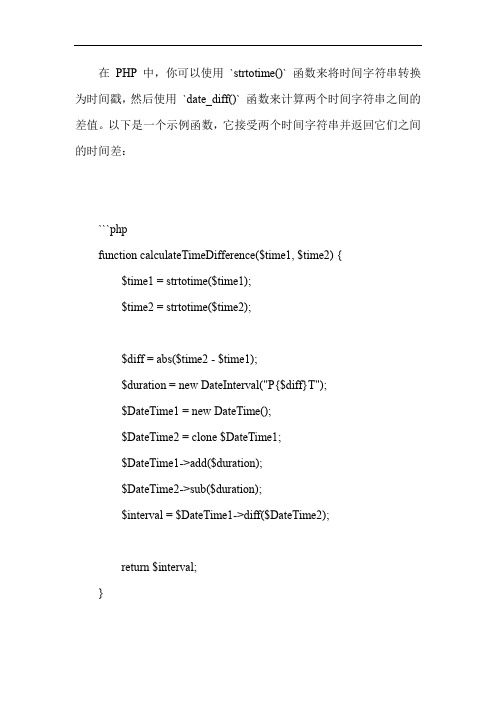
在PHP 中,你可以使用`strtotime()` 函数来将时间字符串转换为时间戳,然后使用`date_diff()` 函数来计算两个时间字符串之间的差值。
以下是一个示例函数,它接受两个时间字符串并返回它们之间的时间差:```phpfunction calculateTimeDifference($time1, $time2) {$time1 = strtotime($time1);$time2 = strtotime($time2);$diff = abs($time2 - $time1);$duration = new DateInterval("P{$diff}T");$DateTime1 = new DateTime();$DateTime2 = clone $DateTime1;$DateTime1->add($duration);$DateTime2->sub($duration);$interval = $DateTime1->diff($DateTime2);return $interval;}// 示例用法$time1 = "2023-07-19 10:00:00";$time2 = "2023-07-19 14:30:00";$difference = calculateTimeDifference($time1, $time2);echo $difference->h; // 输出小时数echo $difference->i; // 输出分钟数echo $difference->s; // 输出秒数```在上面的示例中,`calculateTimeDifference()` 函数接受两个时间字符串`$time1` 和`$time2`。
它首先使用`strtotime()` 函数将时间字符串转换为时间戳,然后计算两个时间戳之间的差值。
phpstorm的使用方法

PHPStorm是一款功能强大的集成开发环境(IDE),专门用于开发PHP应用程序。
以下是PHPStorm的一些常见使用方法:1.项目设置:•打开PHPStorm,选择"File"菜单,然后选择"Open"或"Open Recent"来打开一个项目。
•在"Preferences"(Windows和Linux上为"Settings")中,可以设置默认编码、键盘快捷键、代码样式等。
2.创建和编辑文件:•在项目窗口中,右键点击所选目录,选择"New",然后选择要创建的文件类型,如PHP文件、HTML文件等。
•在编辑器中编写代码,PHPStorm提供了自动完成、语法高亮、代码折叠等功能,可大大提高编码效率。
3.调试和运行:•在工具栏中,点击绿色的播放按钮可运行当前文件。
•可以设置断点,通过点击编辑器左侧行号区域或使用快捷键来添加/移除断点,然后点击调试按钮进行调试。
4.版本控制:•PHPStorm支持与版本控制系统(如Git、SVN)集成。
在"VCS"菜单下,可以进行代码提交、拉取、推送等操作。
5.插件和扩展:•PHPStorm支持许多插件和扩展,可以通过"Plugins"(Windows和Linux上为"Settings" -> "Plugins")中的插件市场进行安装和管理。
6.导航和搜索:•使用"Navigate"菜单,可以快速导航到类、文件、方法等。
•使用"Find"或"Find in Path"功能,可以全局搜索代码。
这只是PHPStorm的一些基本使用方法,它还有许多其他功能,如代码重构、代码检查、自动化测试等。
PHPstrtotime函数详解
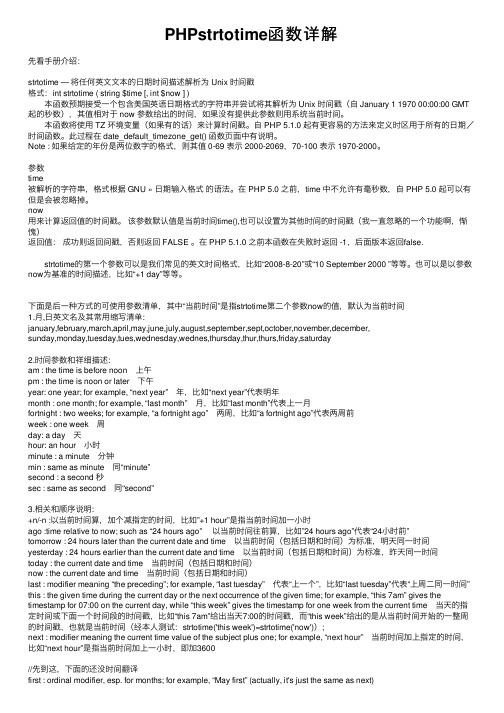
PHPstrtotime函数详解先看⼿册介绍:strtotime — 将任何英⽂⽂本的⽇期时间描述解析为 Unix 时间戳格式:int strtotime ( string $time [, int $now ] ) 本函数预期接受⼀个包含美国英语⽇期格式的字符串并尝试将其解析为 Unix 时间戳(⾃ January 1 1970 00:00:00 GMT 起的秒数),其值相对于 now 参数给出的时间,如果没有提供此参数则⽤系统当前时间。
本函数将使⽤ TZ 环境变量(如果有的话)来计算时间戳。
⾃ PHP 5.1.0 起有更容易的⽅法来定义时区⽤于所有的⽇期/时间函数。
此过程在 date_default_timezone_get() 函数页⾯中有说明。
Note : 如果给定的年份是两位数字的格式,则其值 0-69 表⽰ 2000-2069,70-100 表⽰ 1970-2000。
参数time被解析的字符串,格式根据 GNU » ⽇期输⼊格式的语法。
在 PHP 5.0 之前,time 中不允许有毫秒数,⾃ PHP 5.0 起可以有但是会被忽略掉。
now⽤来计算返回值的时间戳。
该参数默认值是当前时间time(),也可以设置为其他时间的时间戳(我⼀直忽略的⼀个功能啊,惭愧)返回值:成功则返回间戳,否则返回 FALSE 。
在 PHP 5.1.0 之前本函数在失败时返回 -1,后⾯版本返回false. strtotime的第⼀个参数可以是我们常见的英⽂时间格式,⽐如“2008-8-20”或“10 September 2000 ”等等。
也可以是以参数now为基准的时间描述,⽐如“+1 day”等等。
下⾯是后⼀种⽅式的可使⽤参数清单,其中“当前时间”是指strtotime第⼆个参数now的值,默认为当前时间1.⽉,⽇英⽂名及其常⽤缩写清单:january,february,march,april,may,june,july,august,september,sept,october,november,december,sunday,monday,tuesday,tues,wednesday,wednes,thursday,thur,thurs,friday,saturday2.时间参数和祥细描述:am : the time is before noon 上午pm : the time is noon or later 下午year: one year; for example, “next year” 年,⽐如“next year”代表明年month : one month; for example, “last month” ⽉,⽐如“last month”代表上⼀⽉fortnight : two weeks; for example, “a fortnight ago” 两周,⽐如“a fortnight ago”代表两周前week : one week 周day: a day 天hour: an hour ⼩时minute : a minute 分钟min : same as minute 同“minute”second : a second 秒sec : same as second 同“second”3.相关和顺序说明:+n/-n :以当前时间算,加个减指定的时间,⽐如”+1 hour”是指当前时间加⼀⼩时ago :time relative to now; such as “24 hours ago” 以当前时间往前算,⽐如”24 hours ago”代表“24⼩时前”tomorrow : 24 hours later than the current date and time 以当前时间(包括⽇期和时间)为标准,明天同⼀时间yesterday : 24 hours earlier than the current date and time 以当前时间(包括⽇期和时间)为标准,昨天同⼀时间today : the current date and time 当前时间(包括⽇期和时间)now : the current date and time 当前时间(包括⽇期和时间)last : modifier meaning “the preceding”; for example, “last tuesday” 代表“上⼀个”,⽐如“last tuesday”代表“上周⼆同⼀时间” this : the given time during the current day or the next occurrence of the given time; for example, “this 7am” gives the timestamp for 07:00 on the current day, while “this week” gives the timestamp for one week from the current time 当天的指定时间或下⾯⼀个时间段的时间戳,⽐如“this 7am”给出当天7:00的时间戳,⽽“this week”给出的是从当前时间开始的⼀整周的时间戳,也就是当前时间(经本⼈测试:strtotime('this week')=strtotime('now'));next : modifier meaning the current time value of the subject plus one; for example, “next hour” 当前时间加上指定的时间,⽐如“next hour”是指当前时间加上⼀⼩时,即加3600//先到这,下⾯的还没时间翻译first : ordinal modifier, esp. for months; for example, “May first” (actually, it's just the same as next)third : see first (note that there is no “second” for ordinality, since that would conflict with the second time value) fourth : see firstfifth : see firstsixth : see firstseventh : see firsteighth : see firstninth : see firsttenth : see firsteleventh : see firsttwelfth : see first4.时区描述:gmt : Greenwich Mean Timeut : Coordinated Universal Timeutc : same as utwet : Western European Timebst : British Summer Timewat : West Africa Timeat : Azores Timeast : Atlantic Standard Timeadt : Atlantic Daylight Timeest : Eastern Standard Timeedt : Eastern Daylight Timecst : Central Standard Timecdt : Central Daylight Timemst : Mountain Standard Timemdt : Mountain Daylight Timepst : Pacific Standard Timepdt : Pacific Daylight Timeyst : Yukon Standard Timeydt : Yukon Daylight Timehst : Hawaii Standard Timehdt : Hawaii Daylight Timecat : Central Alaska Timeakst : Alaska Standard Timeakdt : Alaska Daylight Timeahst : Alaska-Hawaii Standard Timent : Nome Timeidlw : International Date Line Westcet : Central European Timemet : Middle European Timemewt : Middle European Winter Timemest : Middle European Summer Timemesz : Middle European Summer Timeswt : Swedish Winter Timesst : Swedish Summer Timefwt : French Winter Timefst : French Summer Timeeet : Eastern Europe Time, USSR Zone 1bt : Baghdad Time, USSR Zone 2zp4 : USSR Zone 3zp5 : USSR Zone 4zp6 : USSR Zone 5wast : West Australian Standard Timewadt : West Australian Daylight Timecct : China Coast Time, USSR Zone 7jst : Japan Standard Time, USSR Zone 8east : Eastern Australian Standard Timeeadt : Eastern Australian Daylight Timegst : Guam Standard Time, USSR Zone 9nzt : New Zealand Timenzst : New Zealand Standard Timenzdt : New Zealand Daylight Timeidle : International Date Line East在PHP中有个叫做strtotime的函数。
php 计算两个时间段交集的方法
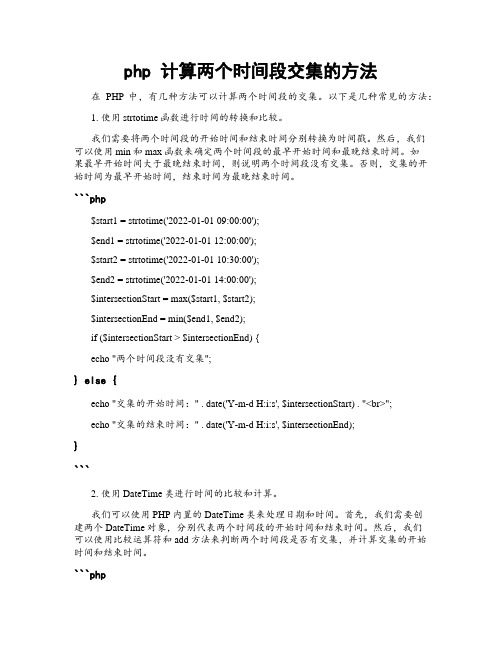
php 计算两个时间段交集的方法在PHP中,有几种方法可以计算两个时间段的交集。
以下是几种常见的方法:1. 使用strtotime函数进行时间的转换和比较。
我们需要将两个时间段的开始时间和结束时间分别转换为时间戳。
然后,我们可以使用min和max函数来确定两个时间段的最早开始时间和最晚结束时间。
如果最早开始时间大于最晚结束时间,则说明两个时间段没有交集。
否则,交集的开始时间为最早开始时间,结束时间为最晚结束时间。
```php$start1 = strtotime('2022-01-01 09:00:00');$end1 = strtotime('2022-01-01 12:00:00');$start2 = strtotime('2022-01-01 10:30:00');$end2 = strtotime('2022-01-01 14:00:00');$intersectionStart = max($start1, $start2);$intersectionEnd = min($end1, $end2);if ($intersectionStart > $intersectionEnd) {echo "两个时间段没有交集";} else {echo "交集的开始时间:" . date('Y-m-d H:i:s', $intersectionStart) . "<br>";echo "交集的结束时间:" . date('Y-m-d H:i:s', $intersectionEnd);}```2. 使用DateTime类进行时间的比较和计算。
我们可以使用PHP内置的DateTime类来处理日期和时间。
首先,我们需要创建两个DateTime对象,分别代表两个时间段的开始时间和结束时间。
PHP时间函数使用详解

PHP时间函数使⽤详解PHP开发中,关于时间函数的使⽤基本上可以说是⽆处不在,⽽PHP中操作时间的⽅法也很多,⽐如PHP时间戳、⽇期与时间戳之间的转换、获取当前⽇期、当前时间之前或之后的时间等等,下⾯我们详细讲述⼀下PHP中各种时间函数的使⽤。
⾸先需要知道的是在php中获取时间⽅法是date(),在php中获取时间戳⽅法有time()、strtotime()。
下⾯分别说明。
date() 格式为:date($format, $timestamp),format为格式、timestamp为时间戳(可选)。
time() 返回当前时间的 Unix 时间戳,没有参数。
strtotime($time, $now) 将格式化的⽇期时间或任何英⽂⽂本的⽇期时间描述解析为 Unix 时间戳。
$time 为必填,规定要解析的时间字符串;$now ⽤来计算返回值的时间戳,如果省略该参数,则使⽤当前时间。
date($format)⽤法举例:echo date('Y-m-d');输出结果:2014-12-16echo date('Y-m-d H:i:s');输出结果:2014-12-16 23:00:00echo date('Y年m⽉d⽇');输出结果:2014年12⽉16⽇要实现输出怎样的⽇期格式其实只需要按规则修改⼀下即可,下⾯是字符串格式中各个字母的含义:a - "am" 或是 "pm"A - "AM" 或是 "PM"d - ⼏⽇,⼆位数字,若不⾜⼆位则前⾯补零; 如: "01" ⾄ "31"D - 星期⼏,三个英⽂字母; 如: "Fri"F - ⽉份,英⽂全名; 如: "January"h - 12 ⼩时制的⼩时; 如: "01" ⾄ "12"H - 24 ⼩时制的⼩时; 如: "00" ⾄ "23"g - 12 ⼩时制的⼩时,不⾜⼆位不补零; 如: "1" ⾄ 12"G - 24 ⼩时制的⼩时,不⾜⼆位不补零; 如: "0" ⾄ "23"i - 分钟; 如: "00" ⾄ "59"j - ⼏⽇,⼆位数字,若不⾜⼆位不补零; 如: "1" ⾄ "31"l - 星期⼏,英⽂全名; 如: "Friday"m - ⽉份,⼆位数字,若不⾜⼆位则在前⾯补零; 如: "01" ⾄ "12"n - ⽉份,⼆位数字,若不⾜⼆位则不补零; 如: "1" ⾄ "12"M - ⽉份,三个英⽂字母; 如: "Jan"s - 秒; 如: "00" ⾄ "59"S - 字尾加英⽂序数,⼆个英⽂字母; 如: "th","nd"t - 指定⽉份的天数; 如: "28" ⾄ "31"U - 总秒数w - 数字型的星期⼏,如: "0" (星期⽇) ⾄ "6" (星期六)Y - 年,四位数字; 如: "1999"y - 年,⼆位数字; 如: "99"z - ⼀年中的第⼏天; 如: "0" ⾄ "365"time()⽤法举例:time();输出结果:1418664250(返回的结果即当前的时间戳)strtotime($time)⽤法举例:echo strtotime('2014-12-16'); 输出结果:1418688000,作⽤其实是把2014-12-16 00:00:00转化为 UNIX 时间戳strtotime()还有个很强⼤的⽤法,参数可加⼊对于数字的操作、年⽉⽇周英⽂字符,⽰例如下:echo date('Y-m-d H:i:s',strtotime('+1 day'));输出结果:2014-12-17 23:30:33(输出明天此时的时间)echo date('Y-m-d H:i:s',strtotime('-1 day'));输出结果:2014-12-15 23:30:33(昨天此时的时间)echo date('Y-m-d H:i:s',strtotime('+1 week'));输出结果:2014-12-22 23:30:33(获取下个星期此时的时间)echo date('Y-m-d H:i:s',strtotime('next Thursday'));输出结果:2014-12-18 00:00:00(获取下个星期四凌晨的时间)echo date('Y-m-d H:i:s',strtotime('last Thursday'));输出结果:2014-12-11 00:00:00(获取上个星期四凌晨的时间)以上举例就这么多了,更多的⾃⼰去变通研究吧,strtotime()⽅法可以通过英⽂⽂本的控制Unix时间戳的显⽰,⽽得到需要的时间⽇期格式。
PHP的日期和时间
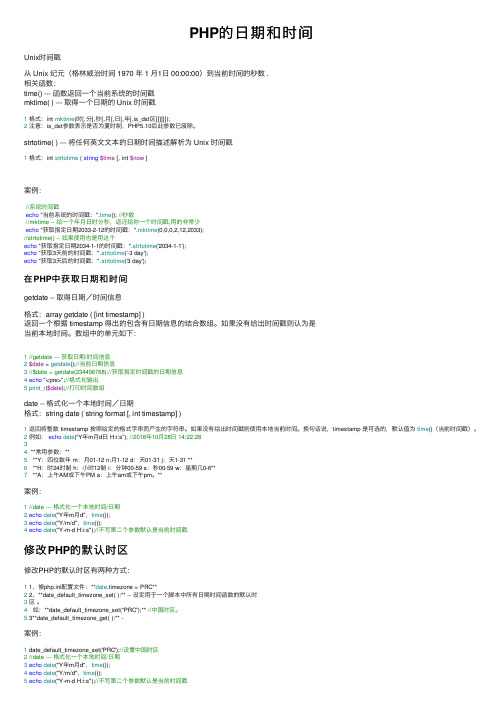
PHP的⽇期和时间Unix时间戳从 Unix 纪元(格林威治时间 1970 年 1 ⽉1⽇ 00:00:00)到当前时间的秒数 .相关函数:time() --- 函数返回⼀个当前系统的时间戳mktime( ) --- 取得⼀个⽇期的 Unix 时间戳1格式:int mktime(时[,分[,秒[,⽉[,⽇[,年[,is_dst区]]]]]]);2注意:is_dst参数表⽰是否为夏时制,PHP5.10后此参数已废除。
strtotime( ) --- 将任何英⽂⽂本的⽇期时间描述解析为 Unix 时间戳1格式:int strtotime ( string$time [, int $now ]案例://系统时间戳echo "当前系统的时间戳:".time(); //秒数//mktime -- 给⼀个年⽉⽇时分秒,返还给你⼀个时间戳,⽤的⾮常少echo "获取指定⽇期2033-2-12的时间戳:".mktime(0,0,0,2,12,2033);//strtotime() -- 如果使⽤也是⽤这个echo "获取指定⽇期2034-1-1的时间戳:".strtotime('2034-1-1');echo "获取3天前的时间戳:".strtotime('-3 day');echo "获取3天后的时间戳:".strtotime('3 day');在PHP中获取⽇期和时间getdate -- 取得⽇期/时间信息格式:array getdate ( [int timestamp] )返回⼀个根据 timestamp 得出的包含有⽇期信息的结合数组。
如果没有给出时间戳则认为是当前本地时间。
数组中的单元如下:1//getdate --- 获取⽇期/时间信息2$date = getdate();//当前⽇期信息3//$date = getdate(234456768);//获取指定时间戳的⽇期信息4echo "<pre>";//格式化输出5print_r($date);//打印时间数组date -- 格式化⼀个本地时间/⽇期格式:string date ( string format [, int timestamp] )1返回将整数 timestamp 按照给定的格式字串⽽产⽣的字符串。
PHP中strtotime函数使用方法
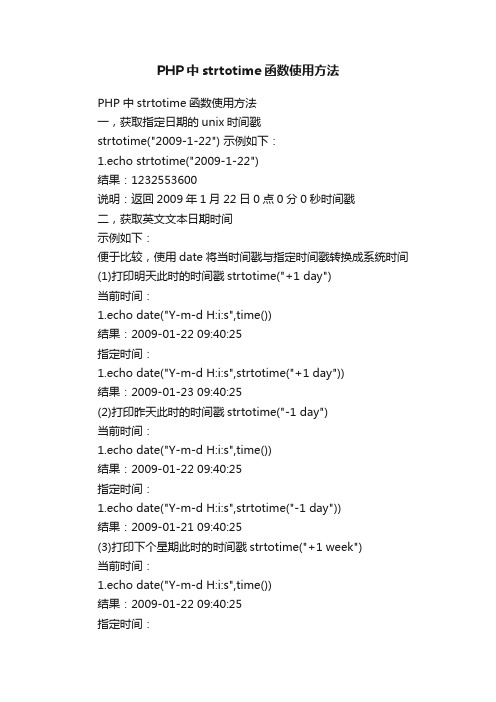
PHP中strtotime函数使用方法PHP中strtotime函数使用方法一,获取指定日期的unix时间戳strtotime("2009-1-22") 示例如下:1.echo strtotime("2009-1-22")结果:1232553600说明:返回2009年1月22日0点0分0秒时间戳二,获取英文文本日期时间示例如下:便于比较,使用date将当时间戳与指定时间戳转换成系统时间(1)打印明天此时的时间戳strtotime("+1 day")当前时间:1.echo date("Y-m-d H:i:s",time())结果:2009-01-22 09:40:25指定时间:1.echo date("Y-m-d H:i:s",strtotime("+1 day"))结果:2009-01-23 09:40:25(2)打印昨天此时的时间戳strtotime("-1 day")当前时间:1.echo date("Y-m-d H:i:s",time())结果:2009-01-22 09:40:25指定时间:1.echo date("Y-m-d H:i:s",strtotime("-1 day"))结果:2009-01-21 09:40:25(3)打印下个星期此时的时间戳strtotime("+1 week")当前时间:1.echo date("Y-m-d H:i:s",time())结果:2009-01-22 09:40:25指定时间:1.echo date("Y-m-d H:i:s",strtotime("+1 week"))结果:2009-01-29 09:40:25(4)打印上个星期此时的时间戳strtotime("-1 week")当前时间:1.echo date("Y-m-d H:i:s",time())结果:2009-01-22 09:40:25指定时间:1.echo date("Y-m-d H:i:s",strtotime("-1 week"))结果:2009-01-15 09:40:25(5)打印指定下星期几的时间戳strtotime("next Thursday")当前时间:1.echo date("Y-m-d H:i:s",time())结果:2009-01-22 09:40:25指定时间:1.echo date("Y-m-d H:i:s",strtotime("next Thursday"))结果:2009-01-29 00:00:00(6)打印指定上星期几的.时间戳strtotime("last Thursday")当前时间:1.echo date("Y-m-d H:i:s",time())结果:2009-01-22 09:40:25指定时间:1.echo date("Y-m-d H:i:s",strtotime("last Thursday"))结果:2009-01-15 00:00:00以上示例可知,strtotime能将任何英文文本的日期时间描述解析为Unix时间戳,我们结合mktime()或date()格式化日期时间获取指定的时间戳,实现所需要的日期时间。
strtotime函数的返回值
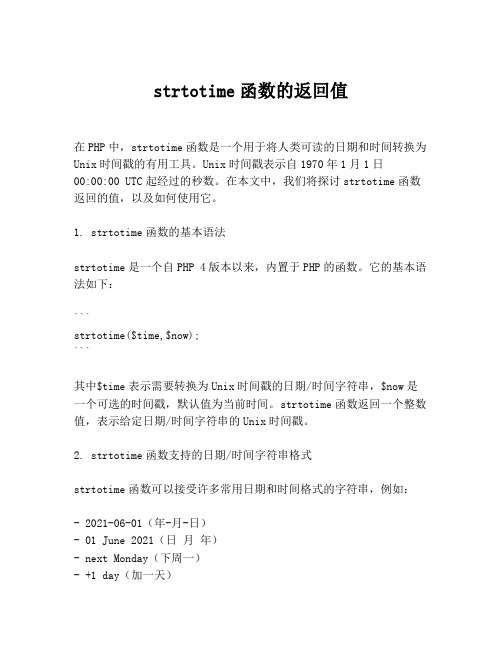
strtotime函数的返回值在PHP中,strtotime函数是一个用于将人类可读的日期和时间转换为Unix时间戳的有用工具。
Unix时间戳表示自1970年1月1日00:00:00 UTC起经过的秒数。
在本文中,我们将探讨strtotime函数返回的值,以及如何使用它。
1. strtotime函数的基本语法strtotime是一个自PHP 4版本以来,内置于PHP的函数。
它的基本语法如下:```strtotime($time,$now);```其中$time表示需要转换为Unix时间戳的日期/时间字符串,$now是一个可选的时间戳,默认值为当前时间。
strtotime函数返回一个整数值,表示给定日期/时间字符串的Unix时间戳。
2. strtotime函数支持的日期/时间字符串格式strtotime函数可以接受许多常用日期和时间格式的字符串,例如:- 2021-06-01(年-月-日)- 01 June 2021(日月年)- next Monday(下周一)- +1 day(加一天)- 2 hours ago(2小时前)- now(现在)3. strtotime函数返回的值strtotime函数返回一个时间戳,它表示1970年1月1日00:00:00 UTC至给定日期/时间字符串的秒数。
例如,如果我们使用以下代码将“2021-06-01”转换为时间戳:```$date = '2021-06-01';$timestamp = strtotime($date);echo $timestamp;```将会得到一个单词值,其中包括“2021年6月1日00:00:00 UTC”之间的秒数。
4. 使用strtotime函数获取特定时间的时间戳我们可以使用strtotime函数来获取指定日期/时间的时间戳。
例如,如果我们想获取“2021年6月1日上午9:00:00”的时间戳,可以使用以下代码:```$date = '2021-06-01 9:00:00';$timestamp = strtotime($date);echo $timestamp;```> 注意:strtotime函数对于年份的解析有限制,只能解析1970年至2038年之间的年份。
- 1、下载文档前请自行甄别文档内容的完整性,平台不提供额外的编辑、内容补充、找答案等附加服务。
- 2、"仅部分预览"的文档,不可在线预览部分如存在完整性等问题,可反馈申请退款(可完整预览的文档不适用该条件!)。
- 3、如文档侵犯您的权益,请联系客服反馈,我们会尽快为您处理(人工客服工作时间:9:00-18:30)。
PHP中strtotime函数使用方法
PHP中strtotime函数使用方法
一,获取指定日期的unix时间戳
strtotime("2009-1-22")示例如下:
1.echostrtotime("2009-1-22")
结果:1232553600
说明:返回2009年1月22日0点0分0秒时间戳
二,获取英文文本日期时间
示例如下:
便于比较,使用date将当时间戳与指定时间戳转换成系统时间(1)打印明天此时的时间戳strtotime("+1day")
当前时间:
1.echodate("Y-m-dH:i:s",time())
结果:2009-01-2209:40:25
指定时间:
1.echodate("Y-m-dH:i:s",strtotime("+1day"))
结果:2009-01-2309:40:25
(2)打印昨天此时的时间戳strtotime("-1day")
当前时间:
1.echodate("Y-m-dH:i:s",time())
结果:2009-01-2209:40:25
指定时间:
1.echodate("Y-m-dH:i:s",strtotime("-1day"))
结果:2009-01-2109:40:25
(3)打印下个星期此时的时间戳strtotime("+1week")
当前时间:
1.echodate("Y-m-dH:i:s",time())
结果:2009-01-2209:40:25
指定时间:
1.echodate("Y-m-dH:i:s",strtotime("+1week"))
结果:2009-01-2909:40:25
(4)打印上个星期此时的时间戳strtotime("-1week")
当前时间:
1.echodate("Y-m-dH:i:s",time())
结果:2009-01-2209:40:25
指定时间:
1.echodate("Y-m-dH:i:s",strtotime("-1week"))
结果:2009-01-1509:40:25
(5)打印指定下星期几的'时间戳strtotime("nextThursday")当前时间:
1.echodate("Y-m-dH:i:s",time())
结果:2009-01-2209:40:25
指定时间:
1.echodate("Y-m-dH:i:s",strtotime("nextThursday"))
结果:2009-01-2900:00:00
(6)打印指定上星期几的时间戳strtotime("lastThursday")
当前时间:
1.echodate("Y-m-dH:i:s",time())
结果:2009-01-2209:40:25
指定时间:
1.echodate("Y-m-dH:i:s",strtotime("lastThursday"))
结果:2009-01-1500:00:00
以上示例可知,strtotime能将任何英文文本的日期时间描述解析为Unix时间戳,我们结合mktime()或date()格式化日期时间获取指定的时间戳,实现所需要的日期时间。
希望通过本文的介绍后,你已经能掌握strtotime函数用法。
